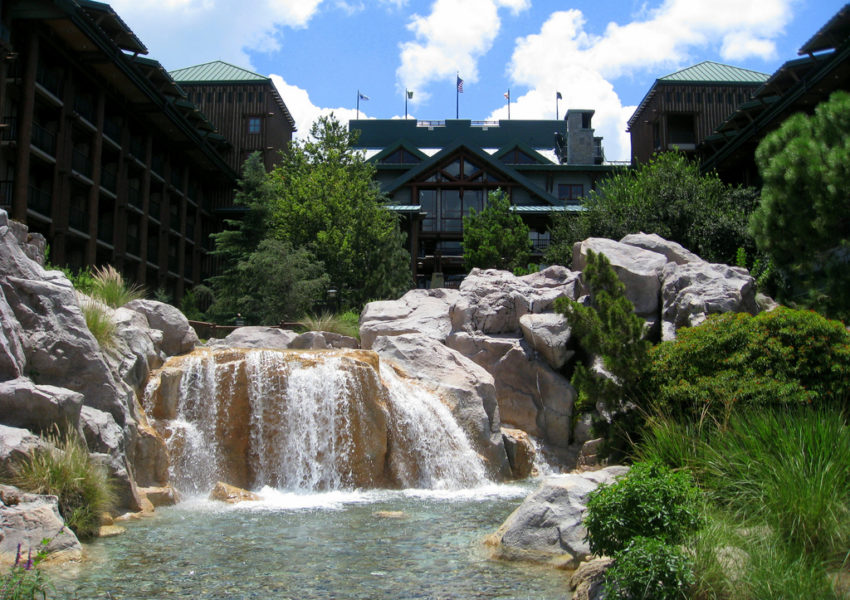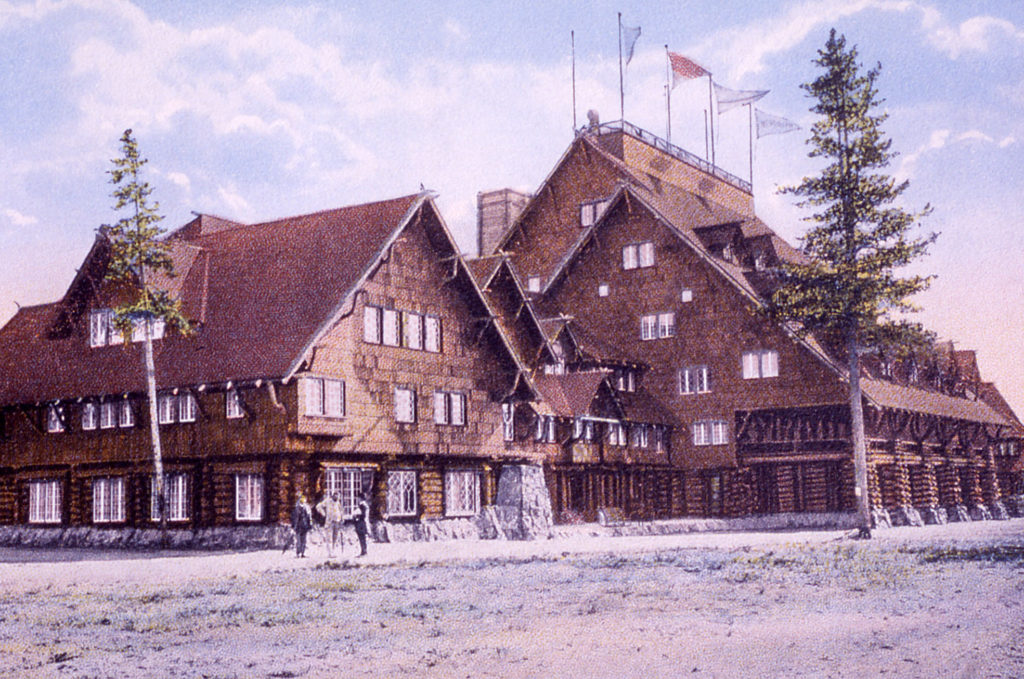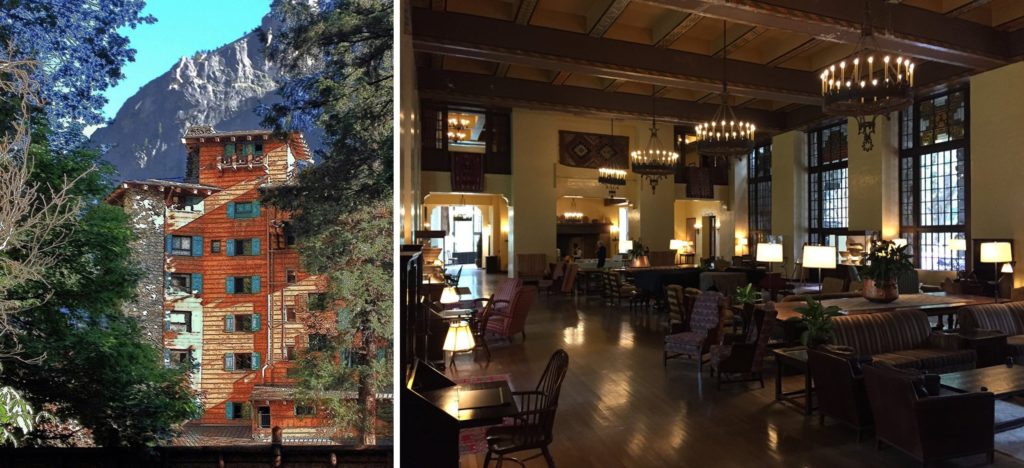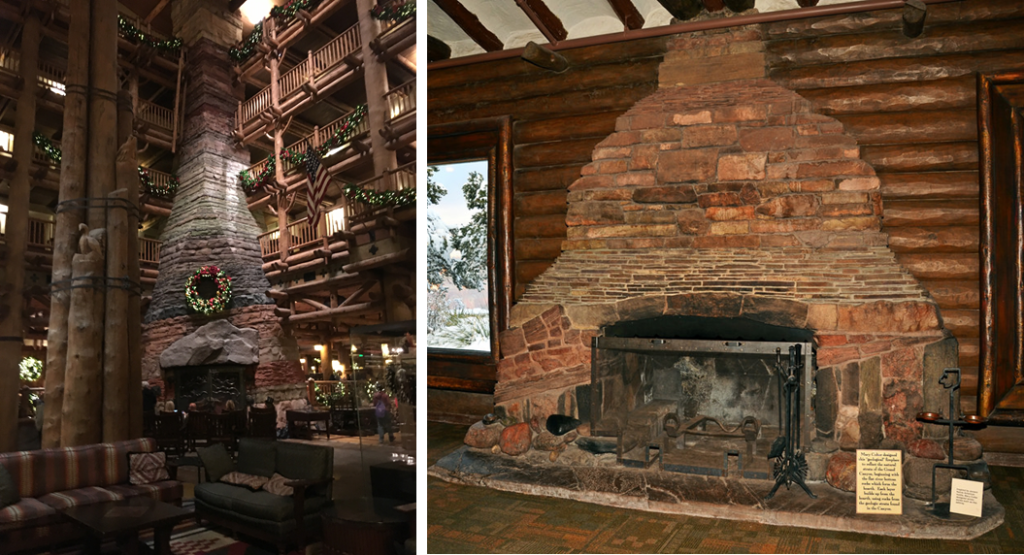
I only “discovered” Disney’s Wilderness Lodge Resort after many years of visiting Walt Disney World. Until then, if my family splurged on a deluxe resort, we chose the Grand Floridian or Polynesian Resorts. Monorail access is a big plus!
When I finally visited the Wilderness Lodge one trip during the Christmas season, I was struck by the beauty and serenity of this resort. Northwestern pines greet guests before they make their way to the main lobby–an expansive six stories trimmed with totem poles, wood carvings, and Native American artifacts. Every aspect of the resort’s design is rich with detail.

This detail, like all Disney properties, is what makes the resort feel “real.” For a moment, you feel transported entirely out of the Florida wetlands and into the American West. But where, exactly, are you transported?
To answer that, we go back to the early 1990s, when Disney hired architect Peter Dominick of Denver-based Urban Design Group to design the Wilderness Lodge. A successful Western architect and the son of a well-known environmentalist, Dominick brought a great passion for the Rocky Mountain West. Indeed, he possessed a special understanding of western building traditions. (Amazingly, despite the structural requirements of a 728-room hotel, he was able to remain faithful to the way a log cabin is constructed). Dominick was also influenced significantly by Stephen Mather, the first director of the National Park Service. Mather championed the use of indigenous building materials that gave his buildings a rustic, more organic quality. Whenever possible, he sought to incorporate natural lighting and Native American influences.

With these principles in mind, Dominick set out to create a hotel reminiscent of the great National Park lodges from the early twentieth-century. These hotels were built for an elite, typically urban, tourist class. Unlike the many wood-frame coastal resorts of the same period, a number of these lodges remain standing and operational today. Fortunately, they did not fall prey to fire as did so many of their time.
The lodges listed below directly inspired Disney’s Wilderness Lodge and are open to visitors. Check them out!
Old Faithful Inn, Yellowstone National Park

Right: Exterior of Disney’s Wilderness Lodge
A National Historic Landmark, Old Faithful Inn (1904) is the most popular place to stay inside Yellowstone National Park. Step inside the seven-story lobby and you’ll recognize the massive central fireplace and log-walled interior. (The hotel is the largest log structure in the world!). Of course, this hotel also looks out onto its namesake geyser–the real one. And like the Wilderness Lodge’s Artists’ Point, Old Faithful Inn celebrates local painters with their Inspired by Yellowstone artist series. Make sure you catch one of the nightly live music performances, every night from 6:00 – 10:00 PM.
Video credit: Yellowstone Forever
Majestic Yosemite Hotel, Yosemite National Park

Right: Hotel Lobby
When designing the Wilderness Lodge, Disney’s architects also went to study the Majestic Yosemite Hotel (formerly the Ahwahnee Hotel built in 1927) in Yosemite National Park. This lodge stands tall with an imposing granite facade and log-beam ceilings. Native American artwork graces the walls and rustic light fixtures dot the ceilings. The Wilderness Lodge legacy can be felt all around.
The architect team weren’t the first Disney visitors–Walt and Lillian themselves stayed here on a vacation in January 1935. This was the family’s first foray into winter sports, and they grew to love ice skating after their visit to the Yosemite Valley.
Lake McDonald Lodge, Glacier National Park

Right: Hotel lobby
Built in 1913, this lodge is nestled along the banks of Lake McDonald in Montana’s Glacier National Park. The accommodations span the main lodge, a nearby row of cabins, and a handful of separate buildings. In the lobby, hanging fixtures feature Native American motifs and majestic landscapes grace the walls. The space is undoubtedly “wilderness” with a cozy feel. However, Swiss-chalet style must also mean European-style amenities, because this hotel lacks air conditioning and elevators. Take note!
Many Glacier Hotel, Glacier National Park

Right: Hotel dining room
You’ll find this lodge a bit further north within Glacier National Park, on the shores of Swiftcurrent Lake. Together with Lake McDonald Lodge, this hotel affirms the region’s other moniker: “the Switzerland of North America.” The Great Northern Railway built this hotel in 1914-15, the brainchild of Louis W. Hill, president of the rail company, who built a number of other chalets in Glacier National Park. The 2001 book Glacier’s Historic Hotels & Chalets: View With a Room offers an interesting account of Hill’s hospitality pursuits.
A recent $42 million renovation updated the lodge inside and out. Major structural repairs corrected a significant tilt, and most major systems were modernized (electrical, fire alarm, plumbing, and accessibility). In addition, the restoration team renovated or restored decorative showpieces. These include the restoration of the dining room’s original, cathedral-type ceiling (previously a drop-ceiling), and the restoration of the lobby’s light fixtures. Sixty new golden cylinders pay homage to the original Japanese lanterns. However, the renovation did not include air conditioning or televisions.
The National Trust for Historic Preservation highlighted the restoration in its Spring 2018 issue of its Preservation Magazine. (This is a great periodical for those interested in historic hotels and preservation in general!).
Jasper Park Lodge, Canada

Right: Lobby at Jasper Park Lodge
The light fixtures that dominate the Disney lobby take their cue from those in Jasper Park Lodge.
The massive, tepee-style Disney fixtures float above lobby. They are made from real rawhide, hand-painted with Native American symbols, and stretched across a metal framework. Look up to see silhouettes of buffaloes and Native Americans on horseback, icons inspired by the photography of Thomas Molesworth. (Many thanks to esteemed Disney historian Jim Korkis for his detailed analysis of this and many other aspects of the Disney resort). While note quite as dramatic, the fixtures at the Jasper Park Lodge also include wildlife silhouetted against a rawhide.
This Fairmont-owned hotel is situated inside Alberta’s Jasper National Park, a designated UNESCO World Heritage Site. Wrapped around the shores of the beautiful Lac Beauvert, the hotel offers 700 acres of year-round activities, including access to one of the nation’s top-rated golf courses, heated pool, and tennis courts. Guests enjoy views that are said to epitomize the “Grand Rocky Mountain Experience.”
The hotel dates back to 1915, when luxury tents dotted the lake shore, giving the area its original name “Tent City.” In 1921, the Canadian National Railways took over and converted the accommodations to log cabins. The resort opened in 1922 as Jasper Park Lodge, and the property continued to be expanded throughout the ensuing decades. Unfortunately, in 1953, a fire destroyed the original structures, but the owners rebuilt using the original blueprints.
Bright Angel Lodge, Grand Canyon National Park

Right: Bright Angel Lodge Lobby
The Wilderness Lodge boasts a soaring lobby dominated by a central fireplace and chimney. Disney guests love gathering around the cozy fireplace, especially during the festive holiday season.
The little-known story behind this fireplace? Its layered stonework represents the geological strata of the Grand Canyon–specifically, the canyon’s south rim. The idea was inspired by the fireplace at the Grand Canyon’s Bright Angel Lodge, whose smaller chimney originated from the layers of the actual might canyon’s walls.
Like the other hotels on this list, the historic Bright Angel Lodge offers a rustic lodge experience. However, this one also stands out for two other features. If you visit, make sure to check out its History Room, which showcases early 1900’s memorabilia from historic postcards to information on the Harvey Girls. After you’re done exploring here, stop by the Harvey House Cafe, a popular restaurant serving–as the name suggests–“diner classics prepared in the Fred Harvey tradition.” Biscuits and gravy are only the beginning of this menu.
El Tovar Hotel, Grand Canyon National Park

Right: El Tovar lobby
For the ultimate real-life Wilderness Lodge experience, look just up the hill from the Bright Angel. Perched precipitously on the canyon’s rim, lies El Tovar Hotel, the crown jewel of historic national park lodges.
This striking hotel opened to the public in 1905 as a joint project of the Atchison, Topeka, and Santa Fe Railway and the Fred Harvey Company. Chicago architect Charles Whittlesey designed this cross between a Norwegian villa and Swiss chalet, in a style that would appeal to European sensibilities of the day. For all its European styling, El Tovar reflects a decidedly western rustic look, with its local quarried limestone and its Oregon pine walls. (Similarly, Disney brought in pine wood from Oregon and Montana to create the lodge poles.) Step inside this grand hotel and step back in time, to an era when sweeping views of the canyon and twinkling stars were the day’s entertainment.
That’s the list! Have you visited any hotels that reminded you of the Wilderness Lodge? Tell us in the comments!
Viewpoints expressed reflect the personal opinions and views of the author. They do not reflect the views of any other entity and should not be read to endorse or otherwise promote any person, business, or service.
